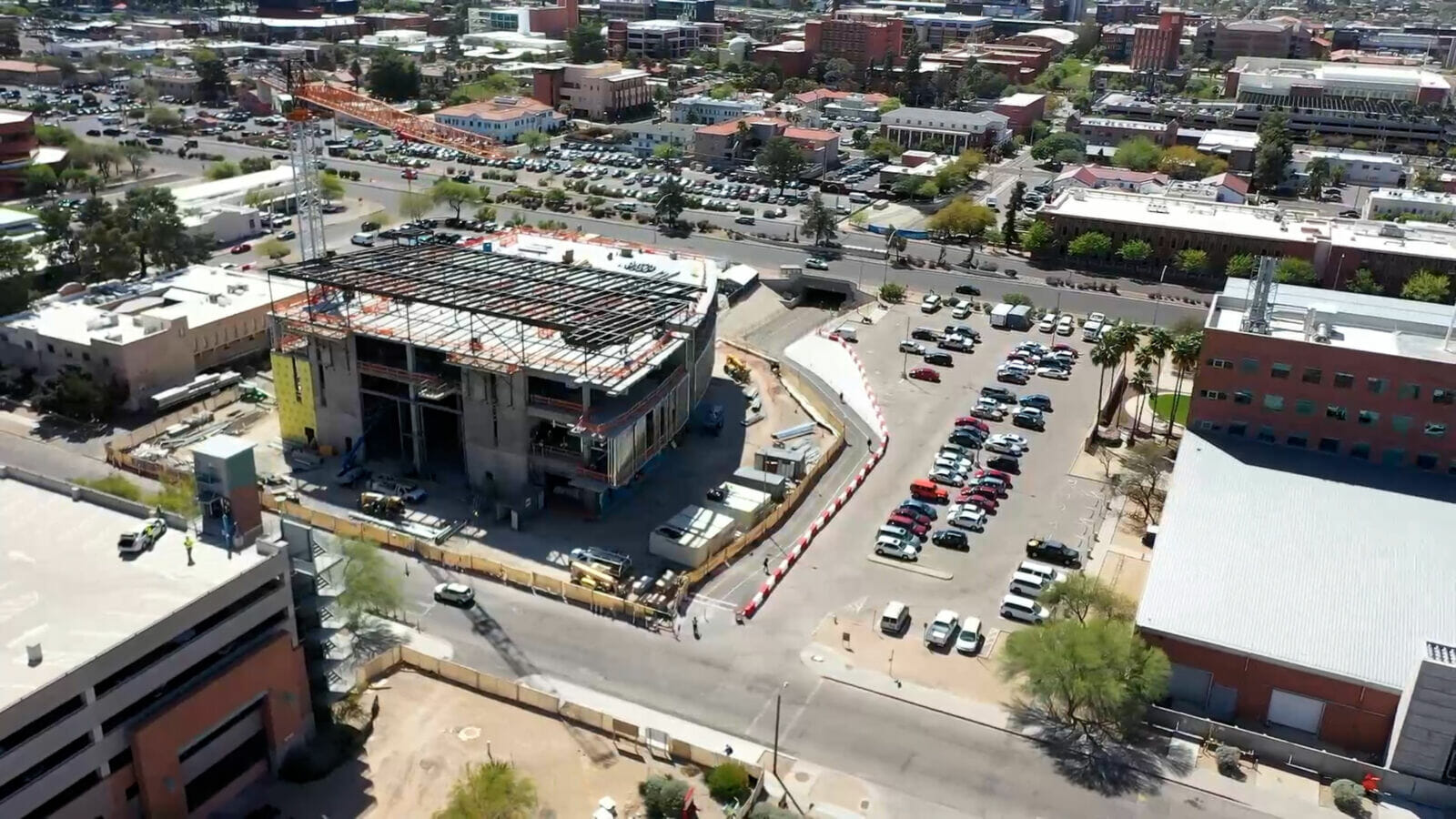The University of Arizona’s new $85-million, four-story Applied Research Building (ARB) recently reached the construction topping-out milestone for the 89,000-square-foot facility. The ARB, located at the southeast corner of Helen Street and the Highland Corridor, will be the future home for research furthering space exploration, advanced manufacturing, and the development of imaging technology, and is expected to complete in January 2023.
READ ALSO: Most Influential Women in CRE: Antonya Williams
Constructed by McCarthy Building Companies and designed by SmithGroup, the building will provide new and regionally unique research capabilities with state-of-the-art equipment and technology while also consolidating a number of interdisciplinary programs to one location. Applied Research Building will have a mix of space types, including high-bay payload assembly areas, a large-scale thermal vacuum chamber, varying types of laboratories, clean rooms, faculty offices, collaboration spaces and conference rooms.
 “In addition to housing world-class, cutting-edge facilities, technologies, and equipment, ARB embodies a collaborative approach that is key to advancing the University’s research enterprise for the 21st C,” remarked R. Brooks Jeffery, UArizona associate vice president for research infrastructure at the topping-out event. “This building will bring together people from multiple disciplines, multiple departments, and multiple external community partners as a collective to approach research as a collaborative process where the facility enables the whole, rather than the siloed parts, of addressing great societal challenges, regardless of how complex, but also glorious, that whole may be.”
“In addition to housing world-class, cutting-edge facilities, technologies, and equipment, ARB embodies a collaborative approach that is key to advancing the University’s research enterprise for the 21st C,” remarked R. Brooks Jeffery, UArizona associate vice president for research infrastructure at the topping-out event. “This building will bring together people from multiple disciplines, multiple departments, and multiple external community partners as a collective to approach research as a collaborative process where the facility enables the whole, rather than the siloed parts, of addressing great societal challenges, regardless of how complex, but also glorious, that whole may be.”
The ARB will focus specifically on research programs related to Pillar 2 of the University’s Strategic Plan, Grand Challenges. These grand challenges include such areas as space exploration, artificial intelligence, the environment, and disease prevention. Several university research programs such as imaging technology, advanced manufacturing, CubeSat design/fabrication/testing, and balloon payload integration will move into the ARB.
Currently located off campus, the university’s Imaging Technology Laboratory is a world-leading supplier of advanced scientific imaging sensors, and the ARB will provide the lab with additional space and cross-campus collaboration opportunities. Technology created by the lab is commonly used for applications such as satellite imagery and in camera systems used on all university-run telescopes.
The ARB also will provide facilities for the design, fabrication, and testing of nanosatellites, which represent the next generation of spacecraft technology for space exploration and scientific investigation by reducing the cost of access to space and expanding the possible range of missions and insights. A large-scale thermal vacuum chamber, which simulates environmental conditions in space and is used to test balloon and satellite performance, will be located in the building and is the largest chamber of its kind at any university in the world.
Although no classes will be taught in the ARB, students will have access to the researchers and facilities within to conduct undergraduate and graduate research.
“As a design-build project, our team fully integrated with our design partners, the owner and its end users to ensure ARB is not only highly functional, but we’ve also been able to overcome many of the supply chain issues that other projects are facing – the result is that ARB is on schedule and on budget even as modifications were made throughout construction,” said Mike Lee, McCarthy’s ARB project director. “Additionally, design-build delivery provided the visibility and flexibility necessary to accommodate and install the massive, irreplaceable, thermal TV chamber and support the University’s research and educational objectives.”
ARB is being designed and constructed by the McCarthy | SmithGroup design-build team. Both McCarthy Building Companies and SmithGroup are national firms with centers of excellence in Arizona. Projects completed on the University of Arizona’s campus by the respective firms include the College of Medicine – Phoenix, the Arizona State Museum collections storage, and the South Stadium Parking Structure.
Construction of the building is designed to meet LEED Silver certification, based on the U.S. Green Building Council’s renowned rating system for sustainably designed buildings.
The team designed the building’s unique curtain wall assemblies to combine glass, metal panels with protruding fin walls and masonry veneer to tie in the colors and design elements of the surrounding facilities.
“The Applied Research Building (ARB) will serve as a state-of-the-art core research facility that supports next-generation space research. The team designed the building’s unique curtain wall assemblies to combine glass, metal panels with protruding fin walls, and masonry veneer to tie in the colors and design elements of the surrounding facilities,” said Stephanie Mitrovic, SmithGroup’s Science & Technology Studio Leader in Phoenix and principal in charge of the project. “In addition, the building will have a prominent campus presence at the intersection of the Highland underpass and a pedestrian promenade.”
As part of the project, the Highland Corridor will be improved and realigned to provide safer pedestrian and bicycle crossings at Helen Street. Additional information about ARB and construction progress is available here and featured in this video.




